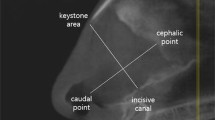Abstract
Background
An aesthetically short nose is very common in Asians. In the past few decades, rhinoplasty in China has focused mainly on the augmentation of the dorsum with alloplastic materials. Alloplastic materials used to augment the nasal tip or for nose lengthening rhinoplasty present a high risk of complications. Therefore, a recent trend in controlling tip projection and rotation is to use an autogenous cartilage graft in Asians. A strong septal extension is mandatory to increase the tip projection and lengthen the nose due to inadequate and inflexible nasal skin in short-nosed patients, whereas cap-and-shield grafting or defattening of the dome or suture modification are used only as additional methods, if necessary.
Methods
Between January 2008 and February 2012, a total of 113 Chinese patients (female-to-male ratio = 101:12) with different degrees of shortened noses, saddle noses, and/or round nasal tip deformities underwent open rhinoplasty. Silicone implants were used for nasal dorsum augmentation in 29 patients and e-PTFE was used in 84 patients. To evaluate the outcomes, nasal length, nasal tip projection, and nasolabial angle were measured pre- and postoperatively in 53 cases. The harvestable septal cartilage were carved into “a” and “b” strips, which were sutured in a “V” shape structure to extend the septum.
Results
Of 113 cases, 78 patients were followed up for an average of 15 months (range = 1 month to 3 years). No major complications associated with implants or e-PTFE during the follow-up period were reported, with the exception of six cases with silicone dorsum augmentation that had an operative look. The results showed that statistically significant differences existed between the pre- and postoperative values in nose length and nose tip projection (p < 0.05). The nasolabial angle presented a reduced trend, although no statistically significant difference was found.
Conclusion
With limited harvestable septal cartilage, the modified technique of septal extension with a septal cartilage graft (or combined with auricular cartilage) is feasible and can effectively improve tip contour in short-nose rhinoplasty.
Level of Evidence V
This journal requires that authors assign a level of evidence to each article. For a full description of these Evidence-Based Medicine ratings, please refer to the Table of Contents or the online Instructions to Authors www.springer.com/00266.











Similar content being viewed by others
References
Kim CH, Jung DH, Park MN, Yoon JH (2010) Surgical anatomy of cartilaginous structures of the Asian nose: clinical implications in rhinoplasty. Laryngoscope 120(5):914–919
Gunter JP, Rohrich RJ (1989) Lengthening the aesthetically short nose. Plast Reconstr Surg 83(5):793–800
Tham C, Lai YL, Weng CJ, Chen YR (2005) Silicone augmentation rhinoplasty in an Oriental population. Ann Plast Surg 54(1):1–5 discussion 6–7
Hodgkinson DJ (2007) The Eurasian nose: aesthetic principles and techniques for augmentation of the Asian nose with autogenous grafting. Aesthetic Plast Surg 31(1):28–31
Jin HR, Won TB (2011) Recent advances in Asian rhinoplasty. Auris Nasus Larynx 38(2):157–164
Ahn J, Honrado C, Horn C (2004) Combined silicone and cartilage implants: augmentation rhinoplasty in Asian patients. Arch Facial Plast Surg 6(2):120–123
Mao GY, Yang SL, Zheng JH, Liu QY (2008) Aesthetic rhinoplasty of the Asian nasal tip: a brief review. Aesthetic Plast Surg 32(4):632–637
Byrd HS, Andochick S, Copit S, Walton KG (1997) Septal extension grafts: a method of controlling tip projection shape. Plast Reconstr Surg 100(4):999–1010
Jin HR, Won TB (2009) Nasal tip augmentation in Asians using autogenous cartilage. Otolaryngol Head Neck Surg 140(4):526–530
Ha RY, Byrd HS (2003) Septal extension grafts revisited: 6-year experience in controlling nasal tip projection and shape. Plast Reconstr Surg 112(7):1929–1935
Han SK, Ko HW, Lee DY, Kim WK (2005) The effect of releasing tip-supporting structures in short-nose correction. Ann Plast Surg 54(4):375–378
Han SK, Lee DG, Kim JB, Kim WK (2004) An anatomic study of nasal tip supporting structures. Ann Plast Surg 52(2):134–139
Lam SM, Kim YK (2003) Augmentation rhinoplasty of the Asian nose with the “bird” silicone implant. Ann Plast Surg 51(3):249–256
Sajjadian A, Naghshineh N, Rubinstein R (2010) Current status of grafts and implants in rhinoplasty: Part II. Homologous grafts and allogenic implants. Plast Reconstr Surg 125(3):99e–109e
Gunter JP, Clark CP, Friedman RM (1997) Internal stabilization of autogenous rib cartilage grafts in rhinoplasty: a barrier to cartilage warping. Plast Reconstr Surg 100(1):161–169
Kim JS, Khan NA, Song HM, Jang YJ (2010) Intraoperative measurements of harvestable septal cartilage in rhinoplasty. Ann Plast Surg 65(6):519–523
Seyhan A, Oaden S, Ozaslan U, Sir E (2007) A simplified use of septal extension graft to control nasal tip location. Aesthetic Plast Surg 31(5):506–511
Jung DH, Loh I (2011) The “X-graft” for nasal tip surgery. Plast Reconstr Surg 128(2):79e–80e
Han SK, Ko HW, Kim WK (2004) Advantages of adding a footplate incision in Asian rhinoplasty. Ann Plast Surg 53(1):65–69
Conflict of interest
The authors have no conflicts of interest to disclose.
Author information
Authors and Affiliations
Corresponding author
Rights and permissions
About this article
Cite this article
Huang, J., Liu, Y. A Modified Technique of Septal Extension Using a Septal Cartilage Graft for Short-Nose Rhinoplasty in Asians. Aesth Plast Surg 36, 1028–1038 (2012). https://doi.org/10.1007/s00266-012-9945-7
Received:
Accepted:
Published:
Issue Date:
DOI: https://doi.org/10.1007/s00266-012-9945-7




